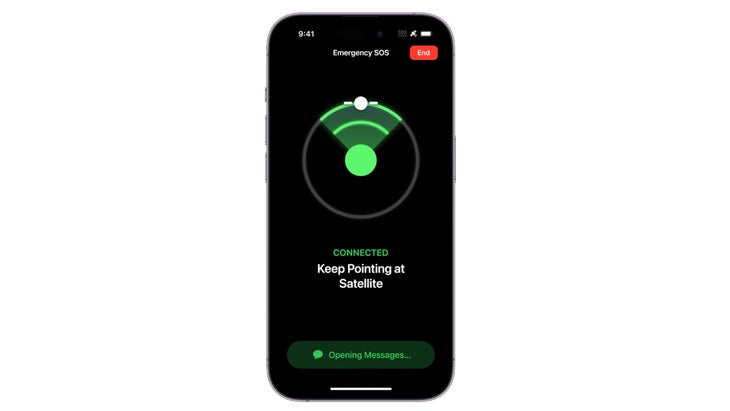



Mike Menand was hiking in the Chattahoochee River National Recreation Area this April when something—maybe a coyote, he told Georgia’s Fox 5 News—scared his dogs and they bolted, causing him to take a serious fall. When the dust settled, Menand’s leg was broken, and he was in so much pain that he couldn’t move or call for help.
Unbeknownst to Menand, his Apple Watch detected the fall. After Menand failed to dismiss the resulting alert, the watch sent an emergency notification to law enforcement, detailing his location and leading to his rescue.
Menand, who ended up needing surgery to place a titanium rod in his leg, credits the watch with saving his life. What’s more, his experience doesn’t appear to be an anomaly. Menand’s story is just the latest in a string of incidents in which the fall and crash detection features on Apple Watch or the satellite SOS feature on the newest generations of iPhones helped hikers and other backcountry travelers summon rescue.
Since Apple released its satellite SOS feature and crash detection on the iPhone 14 and Apple Watch a little over a year ago, “we have had quite a few [rescues related to the technology] in LA County. Over a dozen,” said Assistant Director of the Los Angeles County Sheriff’s Department (LASD), Mike Leum.
In one recent incident, officials received a crash detection alert that took them to a remote mountainside. Rescuers with the department—the largest sheriff’s office in the country—located a vehicle that had fallen 400 feet down the mountain, as well as its owner, who was bleeding profusely from his head.
“We stopped the bleeding, called a helicopter, and got him to an emergency room. He definitely wouldn’t have been alive for much longer without the call,” said Leum.
The iPhone and Apple Watch have a bevy of safety features; some, like the satellite SOS and crash detection, are relatively new, while others, like fall detection, have been available for several years. But what really makes them stand out from competitors is the hands-free engagement: In the event of a crash or a fall, these devices emit a loud sound, warning the owner that they’ll summon emergency services unless the user cancels the call.
In the event that the user doesn’t or is unable to cancel it, the device first attempts to contact law enforcement via a cellular network. If the call cannot be transmitted, it switches to a satellite, notifying the appropriate department of the incident, and giving them the exact GPS coordinates of its location.

In an emergency situation, immediately knowing where the victim is located could be the difference between life and death.
“What we’ve experienced is that there are multiple benefits to this feature,” Leum says. “Number one is the immediate notification that we get. People have an hour to get advanced life support to increase their survivability. In a couple of these incidents, people’s lives were one hundred percent saved because of this feature.”
Steve Goldsworthy, the SAR Technology Director for the LASD, was skeptical of the iPhone’s SOS feature at first. But a year after its integration, he’s changed his tune.
“It’s a complete game changer,” he said.
In a conventional rescue setting, Goldsworthy explains, it could take an hour or more just for someone to find cell service and call for help after witnessing an accident. Once they’re able to connect with law enforcement, the SAR team still has to respond, which takes even more time. The ability to summon help by smartphone via satellite cuts out the middleman, drastically improving emergency response times.
“The GPS position is coming right off of the phone, so it’s extremely accurate,” said Goldsworthy. This allows first responders to identify exactly where the victim is, and to arrange a response team based off of the details the device provides.
While the majority of SOS incidents that SAR members responded to involved vehicular emergencies this year, there have also been a number of backcountry incidents where the feature was used.
Leum said that in one situation, a woman fell down a steep game trail and broke her ankle. After the woman’s phone made an emergency satellite call through the SOS feature, first responders who had just wrapped up another call in the same area were able to identify exactly where she was: “We ran up the trail and within 15 minutes we were with her. We determined she wasn’t able to walk out, even assisted. So we called a helicopter in and got her airlifted to a hospital.”
Summoning help to the scene of a backcountry accident via satellite isn’t a new idea—SPOT, Garmin, and ACR all offer devices that do so—but there’s little question that adding the ability into one of the most popular phones in the world has put it in vastly many more people’s hands. (It is worth noting that iPhones have a modest battery life compared to dedicated beacons—about a day for an iPhone 15 versus 24 days for an inReach Mini on extended tracking mode.) Currently a free feature for iPhone 14 and 15 users, it isn’t yet clear if or when Apple intends to begin charging for the safety feature; the company recently announced it would give the first adopters who bought the iPhone 14 another year of the tech. But in situations where response time is critical, the SOS feature is already making a difference.
“In the backpacking world, so much of what we do is without cell service,” Goldsworthy says. “We have the Pacific Crest Trail that cuts through the back side of LA County. Those mountain peaks go up to 10,000 feet. The north side doesn’t get alot of sun, so in the winter we get alot of snow and ice rescues. Four to 5 feet of snow isn’t unusual…but this kind of technology is truly a lifesaver.”
Like the Garmin inReach and the Spot X, the Apple SOS feature provides two-way communication between the victim and first responders, which better enables an situation-specific rescue.
“The great thing about that feature—there are many great things about this feature—is that it is a two way communication device,” says Leum. “So when they send the 911 text message, the station can reply and find out very important information like: Is anybody hurt? How many people are with you? Does anyone have any medical conditions?”
The satellite SOS technology hasn’t been without its detractors, who worry it could lead to recklessness on the part of hikers or wasted time for rescuers. For the most part, though, Goldsworthy and Leum agree that the tool hasn’t been abused. Still, there have been some cases of misuse. In one early situation, the LASD nearly dispatched a full rescue team to find a subject who, it turned out, was merely low on gas.
Additionally, shortly after its initial release, the crash detection feature struggled at ski resorts.
“In some ski areas they were getting bombarded with these [SOS] notifications. People would crash while they were skiing,” Leum says. As rescuers and Apple identified trends like these, they were better able to tweak the technology to reduce mistaken calls.
Goldsworthy, who has worked directly with Apple’s tech team to fine-tune the SOS software, explained that walking the line between reducing false alarms and enabling victims to get through to first responders is a delicate task.
“Those are the kinds of things they’ve tweaked over time because there’s a balance between wanting to minimize false alarms and also not delay emergency services,” he says. “If we were to get an SOS call, we’d treat it very seriously because of the success rate that we’ve had.”
When asked where he sees the technology going in a year, Goldsworthy says he hopes emergency satellite messaging is available on more devices—Apple or Android.
“I, personally, am not an iPhone user,” he says. “So, I’d love to see the technology rolled into every cell phone out there.”
From 2023

